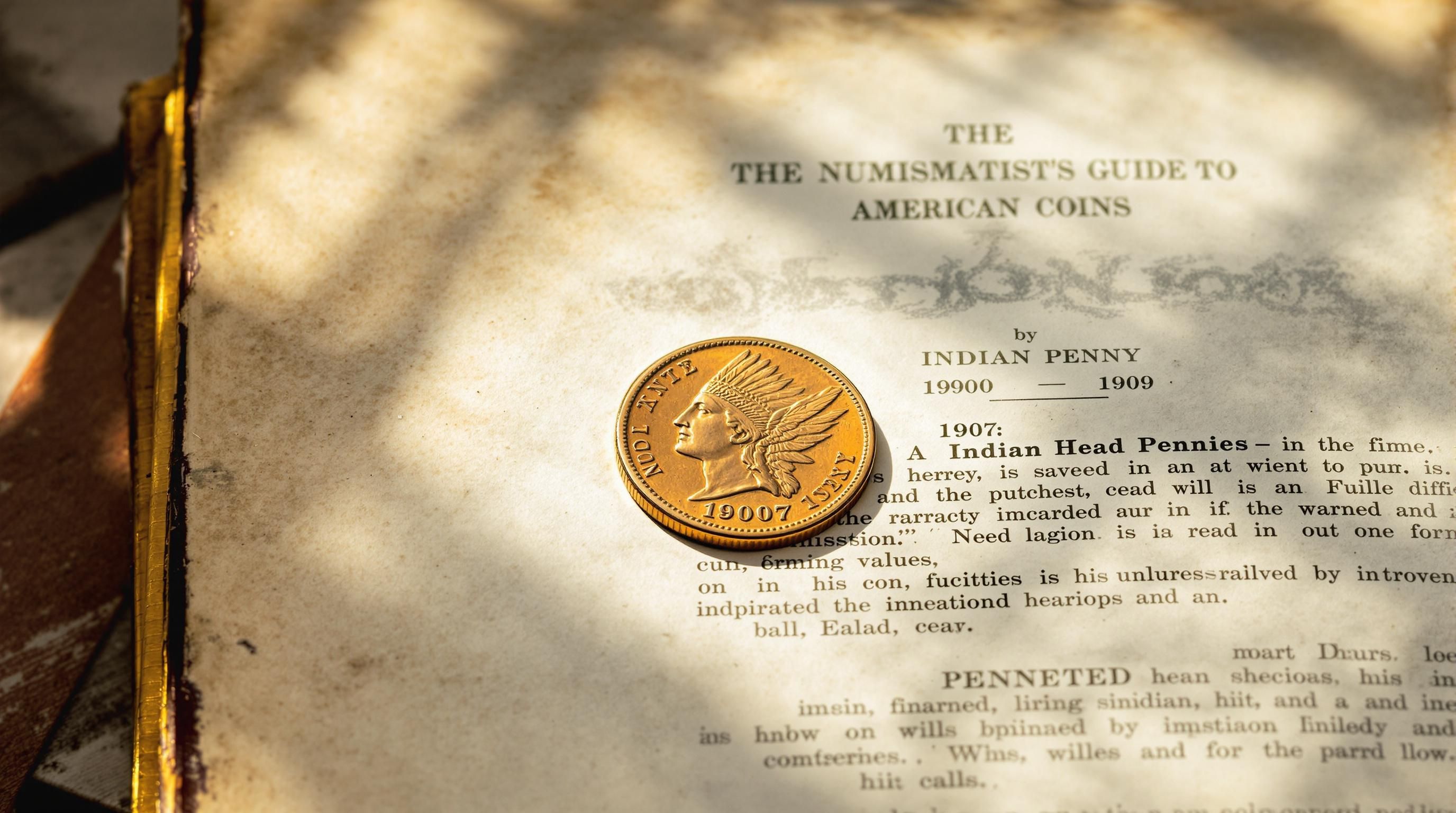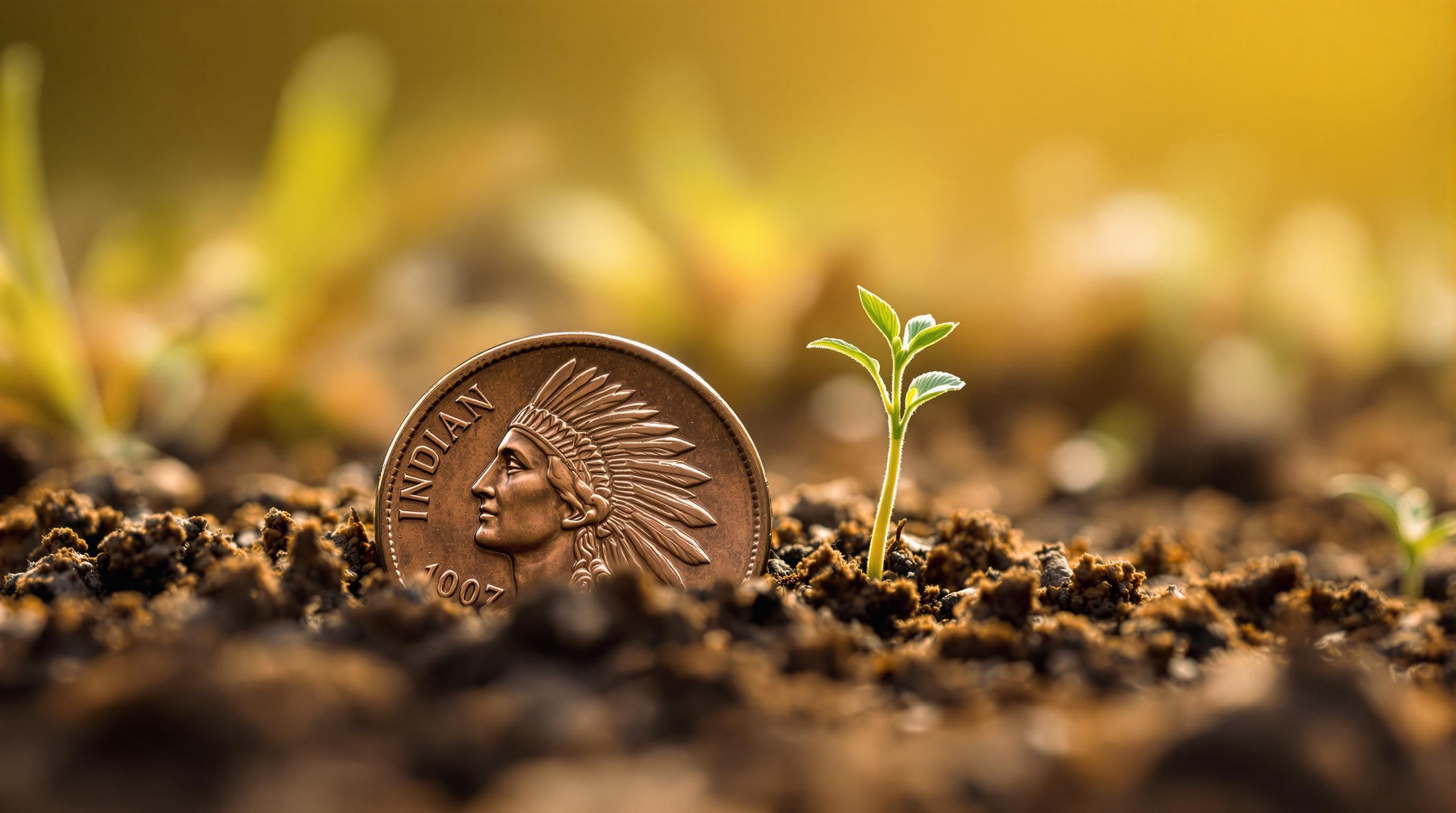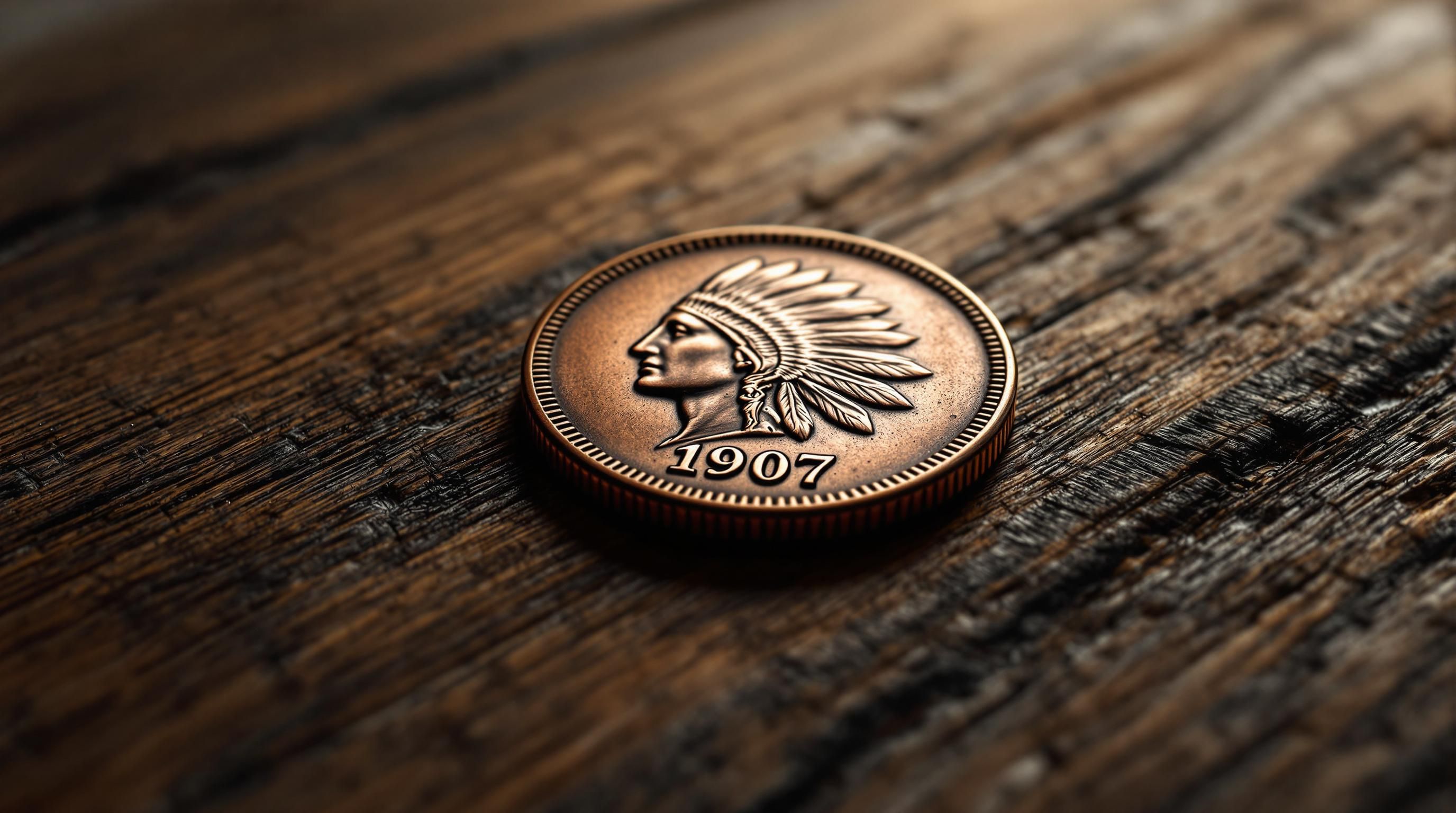Introduction to the 1907 Indian Head Penny
The 1907 Indian Head penny holds significant historical value as one of the last years of production before the introduction of the Lincoln cent in 1909. With over 108 million produced at the Philadelphia Mint, these pennies are relatively common, yet still highly collectible. Whether you’ve discovered one in an old collection, received it as an inheritance, or are actively seeking to add one to your numismatic portfolio, understanding its value is essential.
Key Facts About 1907 Indian Head Pennies
What Factors Determine a 1907 Indian Head Penny’s Value?
The value of your 1907 Indian Head penny depends on several key factors:
- Condition/Grade - The better preserved your coin, the more valuable it will be
- Color - Copper coins are categorized as Brown, Red-Brown, or Red
- Strike Quality - How well the details were impressed during minting
- Errors & Varieties - Any minting errors can significantly increase value
- Provenance - History of ownership can add premium value
Let’s examine each of these factors in detail to help you determine what your 1907 penny might be worth.
1907 Indian Head Penny Grading & Condition
Understanding Grade Categories for Indian Head Pennies
Good (G-4 to G-6): In this condition, major design elements are visible but heavily worn. The portrait’s features are flattened, and the headband may be barely visible. The lettering is readable but worn. Most 1907 pennies found in circulation fall into this category.
Fine (F-12 to F-15): More details appear in Liberty’s hair and the feathers in the headdress. The headband with “LIBERTY” shows some letters clearly. The reverse shows more defined details in the wreath.
Very Fine (VF-20 to VF-35): Most of the feather details are visible, and the headband clearly shows “LIBERTY.” The wreath on the reverse shows good detail.
Extremely Fine (EF-40 to EF-45): Only slight wear appears on the highest points. Almost all details are clear, with just minor flattening on the highest points of the design.
About Uncirculated (AU-50 to AU-58): The coin shows very little wear, with just slight friction on the highest points. Most luster remains.
Mint State (MS-60 to MS-70): No wear from circulation, though quality ranges from coins with many marks (MS-60) to perfect specimens (MS-70). Few 1907 Indian Head pennies exist above MS-65.
1907 Indian Head Penny Value by Grade
Current market values as of 2023
</tbody>
</table>
The Importance of Color for Copper Coins
The 1907 Indian Head penny’s original color was a bright reddish-orange when newly minted. Over time, copper naturally darkens through oxidation. Numismatists classify Indian Head pennies by three color designations:
- Brown (BN): The most common, where the coin has darkened to a brown color
- Red-Brown (RB): Showing a mix of original red color and brown toning
- Red (RD): Retaining most of the original bright copper color, rare for 1907 pennies
Red specimens command significant premiums, especially in higher grades, as they represent extraordinarily well-preserved examples of these historic coins.
1907 Indian Head Penny Key Features
Obverse (Front) Design Features
- Portrait: Lady Liberty wearing a Native American feathered headdress
- Headband: Contains the word “LIBERTY”
- Inscription: “UNITED STATES OF AMERICA” around the rim
- Date: “1907” at the bottom
- No Mint Mark: All 1907 Indian Head pennies were struck at Philadelphia
Reverse (Back) Design Features
- Denomination: “ONE CENT” inside a wreath of oak and laurel
- Wreath: Tied with a ribbon at the bottom
- Shield: Small shield at the top of the wreath
- Composition: 95% copper, 5% tin and zinc (bronze)
- Weight: 3.11 grams
- Diameter: 19.05 mm
Authenticity Check for 1907 Indian Head Pennies
Use this checklist to verify your coin's authenticity
- LIBERTY is visible in the headband (may be worn on circulated coins)
- Design shows appropriate style for 1907 (compared to reference images)
- Weight is approximately 3.11 grams (can vary slightly with wear)
- Diameter measures 19.05 mm (penny-sized)
- Metal appears to be copper/bronze (not magnetic)
- Details align with known design elements (no unusual features)
1907 Indian Head Penny Proof Coins
Besides the regular strike pennies made for circulation, the Philadelphia Mint also produced a limited number of proof coins in 1907. These were specially struck with polished dies on polished planchets, creating coins with exceptional detail and mirror-like fields.
Key facts about 1907 proof Indian Head pennies:
- Mintage: Only 1,475 proofs were struck
- Characteristics: Mirror-like fields, sharp details, sometimes square edges
- Value Range: $180-$1,950+ depending on condition and color
- Rarity: Much rarer than business strikes, especially in Red designation
Proof coins were primarily made for collectors and presentation purposes, not for circulation. Their much lower mintage makes them significantly more valuable than regular strike pennies.

Rare 1907 Indian Head Penny Errors and Varieties
Common Errors Found on 1907 Indian Head Pennies
- Die Cracks: Raised lines on the coin surface caused by cracks in the die
- Doubled Dies: Showing doubling of design elements due to multiple impressions from the die
- Off-Center Strikes: When the coin blank was not properly centered during striking
- Repunched Dates: Where the date was punched multiple times at slightly different positions
- Clipped Planchets: Coins with a portion missing due to an error in cutting the blank
- Lamination Errors: Flaws in the metal planchet causing layers to separate
Let’s look at some specific 1907 Indian Head penny errors and their approximate values:
1907 Indian Head Penny Error Values
Estimated values for common error types
| Category | Price | Notes | |
|---|---|---|---|
| Grade | Brown (BN) | Red-Brown (RB) | Red (RD) |
| Good (G-4) | $2 - $3 | N/A | N/A |
| Fine (F-12) | $4 - $5 | N/A | N/A |
| Very Fine (VF-20) | $7 - $10 | N/A | N/A |
| Extremely Fine (EF-40) | $15 - $20 | N/A | N/A |
| About Uncirculated (AU-50) | $25 - $35 | $35 - $45 | N/A |
| Mint State (MS-63) | $60 - $85 | $95 - $120 | $125 - $165 |
| Mint State (MS-65) | $175 - $225 | $275 - $350 | $500 - $750 |
| Proof | $180 - $250 | $275 - $400 | $900 - $1,950 |
</tbody>
</table>
How to Identify Potential Errors
To spot possible errors on your 1907 Indian Head penny:
- Use a magnifying glass (5x to 10x) to examine the coin closely
- Check the date numbers for signs of repunching or doubling
- Look at design elements for any doubling or unusual characteristics
- Examine the rim for any irregularities or clips
- Look for raised lines across the surface that might indicate die cracks
Remember that many apparent “errors” may simply be post-mint damage. Proper authentication by a professional is recommended for any coin you believe may be a valuable error.

Historical Context and Collectibility
Historical Timeline: The 1907 Indian Head Penny in Context
- 1859
Indian Head Penny Introduction
James B. Longacre designs the Indian Head penny, which begins production - 1864
Composition Change
Penny composition changes from copper-nickel to bronze (95% copper, 5% tin and zinc) - 1907
Peak Production Era
Over 108 million pennies struck at Philadelphia during Theodore Roosevelt's presidency - 1909
End of Series
Indian Head penny production ends, replaced by the Lincoln cent - 1950s-1960s
Collecting Boom
Indian Head pennies become popular among collectors, driving prices upward - Present
Continued Appreciation
Values continue to rise, especially for high-grade and error specimens
Why Collectors Value the 1907 Indian Head Penny
- Historical Significance: One of the last years of this iconic American design
- Aesthetic Appeal: The distinctive portrait of Liberty in a Native American headdress
- Series Completion: A key date for collectors completing an Indian Head penny set
- Accessibility: Common enough to be affordable for beginning collectors
- Investment Potential: Higher grades continue to appreciate in value
How to Sell Your 1907 Indian Head Penny
If you’ve determined that your 1907 Indian Head penny has significant value and you’re interested in selling, here are some options to consider:
- Coin Dealers: Local or online coin dealers can offer immediate payment, though possibly below retail value
- Auction Houses: Major auction houses like Heritage or Stack’s Bowers for rare, high-value specimens
- Online Marketplaces: eBay, Amazon, or specialized coin marketplaces
- Coin Shows: Events where collectors and dealers gather to buy, sell, and trade
- Direct to Collectors: Through coin clubs or online forums
For pennies worth under $100, direct sales through online platforms may be most profitable. For valuable specimens worth hundreds or thousands, professional authentication through PCGS or NGC is recommended before selling through an auction house or high-end dealer.
Tips for Handling and Storing Your 1907 Indian Head Penny
Best Practices for Coin Care
- Always hold coins by the edge, never touching the obverse or reverse surfaces
- Use cotton gloves when handling uncirculated or high-grade specimens
- Never clean your coins as this can significantly reduce their value
- Store in proper coin holders - non-PVC flips, coin capsules, or album pages
- Keep in a stable environment away from humidity and temperature fluctuations
- Consider professional grading and encapsulation for valuable specimens
Warning: Many well-intentioned collectors have unwittingly damaged valuable coins through improper cleaning. Even gentle cleaning can remove the natural patina that develops over decades, significantly reducing a coin’s value to collectors.
Frequently Asked Questions About 1907 Indian Head Pennies
Is my 1907 penny worth anything?
Yes, all 1907 Indian Head pennies have value above their face value. At minimum, even in poor condition, they're worth around $1.50-$2. In average circulated condition (Good to Fine), they typically sell for $2-$5. Better condition coins can be worth significantly more, with uncirculated examples potentially worth $50-$750+ depending on grade and color. Proof specimens can exceed $1,000 in top condition.
Where is the mint mark on a 1907 Indian Head penny?
There is no mint mark on 1907 Indian Head pennies because they were all produced at the Philadelphia Mint, which did not use a mint mark at that time. All 108,138,618 pennies struck in 1907 came from the Philadelphia facility.
What makes a 1907 Indian Head penny rare?
While the 1907 Indian Head penny isn't rare in circulated grades due to its high mintage, certain factors can make individual specimens rare and valuable:
- High-grade uncirculated examples (MS-65 or better)
- Red (RD) color designation in uncirculated grades
- Proof strikes (only 1,475 made)
- Error coins with significant minting mistakes
- Well-preserved examples with original surfaces
The rarest 1907 pennies are Red Proofs in perfect condition, which can sell for thousands of dollars.
How can I tell if my 1907 penny is a proof coin?
Proof 1907 Indian Head pennies have several distinctive characteristics:
- Mirror-like fields (background areas) that are highly reflective
- Sharper, more defined details than regular strikes
- Often have square edges rather than rounded
- May show "cartwheel" effect when rotated under light
- Sometimes have a different color tone than circulation strikes
Because only 1,475 proofs were made, they’re quite rare. Professional authentication is recommended if you suspect you have a proof specimen.
What are the most valuable 1907 Indian Head penny errors?
The most valuable 1907 Indian Head penny errors include:
- Major doubled die varieties showing clear doubling
- Off-center strikes (with the date still visible)
- Dramatic die cracks affecting major design elements
- Wrong planchet errors (struck on a different denomination’s blank)
- Multiple strike errors
Some significant errors can increase the value of an otherwise common 1907 penny to several hundred or even thousands of dollars. Dramatic errors are both rare and highly sought by collectors.
Should I clean my 1907 Indian Head penny to improve its appearance?
No, you should never clean your 1907 Indian Head penny (or any collectible coin). Cleaning removes the natural patina that has developed over decades and can leave hairline scratches that permanently damage the surface. Collectors and dealers can easily identify cleaned coins, which typically sell for 50-80% less than their uncleaned counterparts in the same grade. If your coin appears dirty or discolored, it's best to leave it as is and let a professional evaluate its true condition.
How do copper coin color designations affect the value of my 1907 penny?
Color designation significantly impacts the value of uncirculated 1907 Indian Head pennies:
- Brown (BN): Most common, worth the least (though still valuable in high grades)
- Red-Brown (RB): Shows some original mint red color, commands premium over brown
- Red (RD): Retains most original mint color, most valuable and rarest designation
For example, in MS-65 grade, the same coin might be worth $200 with a Brown designation, $300 as Red-Brown, and $600+ as Red. The effect becomes even more pronounced in proof specimens, where Red examples can command more than three times the value of Brown examples.
Is professional grading worth it for my 1907 Indian Head penny?
Professional grading is generally worth the cost for 1907 Indian Head pennies in these situations:
- Uncirculated examples (Mint State)
- Proof specimens
- Coins that appear to have significant errors
- Specimens that retain original red color
- Any coin you believe may be worth $100+
Professional grading from PCGS or NGC provides authentication, accurate grading, and protection in a sealed holder. For common circulated 1907 pennies in Good to Fine condition, the grading cost (typically $20-30+ per coin) likely exceeds any potential increase in value.
External Resources for 1907 Indian Head Penny Valuation
JM Bullion's 1907 Indian Head Penny Guide
Comprehensive guide to the 1907 Indian Head penny with pricing information and historical context.
USA Coin Book - 1907 Indian Head Cent Values
Detailed pricing information for 1907 Indian Head pennies in various grades and conditions.
U.S. Gold Bureau - 1907 Indian Head Penny Worth
Expert analysis of factors affecting the value of 1907 Indian Head pennies in today's market.
Coin Value Checker - 1907 Indian Head Penny
Comprehensive guide including error varieties and grading information for the 1907 Indian cent.
Professional Coin Grading Service (PCGS)
Official PCGS price guide and population reports for the 1907 Indian Head penny.
Littleton Coin Company - 1907 Indian Head Cent
Retail source for 1907 Indian Head pennies with educational information and collecting supplies.
Conclusion: Is Your 1907 Indian Head Penny a Hidden Treasure?
The 1907 Indian Head penny represents an important piece of American numismatic history. While most examples in circulated condition are worth between $2 and $20, certain specimens—particularly those in high grades with original red color, proof strikes, or significant errors—can be worth hundreds or even thousands of dollars.
Remember these key points about 1907 Indian Head penny values:
- Condition is crucial - The difference between Good and Mint State can mean a 50x increase in value
- Original color matters - Red specimens command significant premiums
- Errors add value - Look for doubling, off-center strikes, and die cracks
- Proofs are rare - Only 1,475 were made and they’re worth $180-$1,950+
- Proper storage preserves value - Never clean coins and handle them carefully by the edges
Whether your 1907 Indian Head penny is worth a few dollars or several hundred, it remains a tangible connection to America’s past and a fascinating piece of numismatic history. If you believe you have a particularly valuable example, consider professional authentication and grading to maximize its potential value.
Get a Professional Appraisal
Unsure about your item’s value? Our certified experts provide fast, written appraisals you can trust.
- Expert report with photos and comps
- Fast turnaround
- Fixed, upfront pricing
No obligation. Secure upload.
| Category | Price | Notes |
|---|---|---|
| Error Type | Description | Approximate Value |
| 10-15% Off-Center Strike | Design is noticeably off-center but date still visible | $100 - $200 |
| 25%+ Off-Center Strike | Severely off-center but with visible date | $200 - $400 |
| Repunched Date (RPD) | Date numbers show doubling from multiple punches | $50 - $150 |
| Major Die Crack | Prominent raised line across important design elements | $25 - $100 |
| Clipped Planchet | Missing portion of the coin due to improper cutting | $40 - $150 |
| Doubled Die Obverse/Reverse | Noticeable doubling of design elements | $75 - $300+ |




